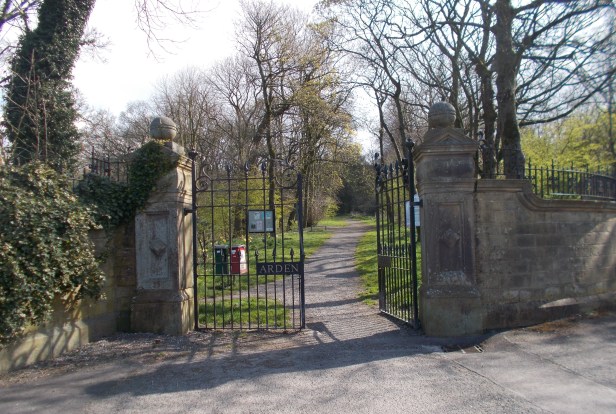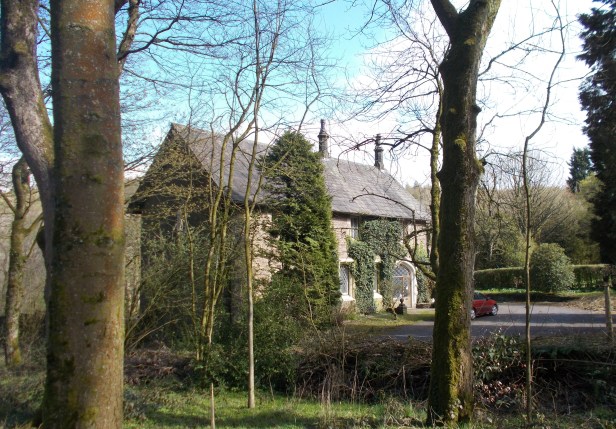Benjamin Hargreaves had Arden Hall built for himself in 1845. He came from a local wealthy mill owning family. His father had made his fortune when he transitioned from being the manager of Broad Oak Printworks to being the joint owner with Adam Dugdale. They invested in new machinery, pioneered innovative printing techniques and came up with new designs for cotton prints. All six of James’s sons worked at the printworks, starting at the bottom. Benjamin took his turn working there in the early 1820s, but did not stay long. He left in 1823 to study botany and chemistry in Edinburgh and it was on his return that he had Arden Hall constructed.

Before work began on the house, he had a local track that passed over his land diverted. This was a route used by workers at Plantation Mill, and he had a better, purpose built road constructed which now ran along the side of his property. (This is Plantation Road, a very long ‘cobbled’ street that is still in excellent condition, see here.)
Arden Hall was a grand house made of stone blocks, with ornate large Tudor-style chimneys. Standing on an eleven acre site, it had commanding views over the moors. The interior consisted of five large bedrooms, dressing rooms, a large drawing room, dining room and a study. The servants had their own hall in which to take their meals. Like many large houses, it had stables and a coach house. The carriageway wound its way through a large garden planted up with limes, yews and hollies.
Like the rest of his family, Benjamin was a keen supporter of public works in the town. He established the Peel Institute (now the Town Hall building) and contributed to the Mechanics Institute and Accrington Subscription Library (of which he was the first member). He was a benefactor of Christ Church and its day school, along with St John’s Church. Shortly after his death in 1880, the school on Plantation Road opened which still bears his name. He left no heir and so the house and contents went up for auction.

New Owners
Joseph Edward Rielly, a local JP and County Alderman, bought Arden Hall and settled there with his wife. During his time the house was extended and remodelled. A major innovation of the time, central heating, was also introduced. A boiler was installed at the rear of the property and this would heat the house via radiators in the rooms.
When he died in 1910, the house went up again for auction. From the inventory we can see how much it had been extended. There were now three entertaining rooms, a large billiards room, six principal bedrooms and four secondary ones, along with “two excellent bathrooms and lavatories”. The new owner was A.S. Bury, an Alderman and former Accrington mayor.
In 1948, the estate was abandoned and the house demolished. The grounds were little used, except for girl guides camping in the gardens. By the end of the 20th century the site was in a poor state, suffering from the effects of vandalism and fire.

A New Beginning for the Site
With the formation of the Friends of Arden Hall group, things took an upward turn. They applied for funding to improve the footpaths and repair the historic gateway at the end of the drive. This involved getting a replica gate made, along with adding railings on top of the wall. These had been removed for scrap metal during the Second World War.
More recently, there has been an archaeological community dig. This exposed the stone foundation that bounded the house, and the internal partitions of the rooms. The fireplaces were located in some of the rooms, and the boiler room was found at the back of the building. Floor tiles also existed in some of the rooms, including some Minton ones that have a maker’s mark that can be dated between 1863-72, so contemporary with Benjamin Hargreaves time.

It appears that the when the house was demolished much of the ground floor was removed so the debris that remained was dropped into the cellars. Many of the finds from the dig occurred in this demolition layer, and these included clay tobacco pipes, glass bottles, pottery and cockle shells (presumably the remnants of a food source).
Visiting the ruins of the hall today, you can still see the outline of its footprint, preserved as the large stone blocks that run around its perimeter. Close examination shows that these are joined using cast iron butterfly shaped wall ties. The porch and vestibule can clearly be seen at the front of the hall, close to the driveway. Two steps lead from the porch through the main door into the vestibule area. The interior parts of the house are more difficult to see, as nature is encroaching and plants begin to establish themselves.
The gardens retain many of their original trees such as the hollys and yews. The footpath winds up from the restored gateway, presumably along what was the carriageway. The visitor will be struck by how well maintained the grounds are. There is very little litter, and the grounds are being actively managed by the pruning of trees and creation of habitat piles. Much of this is done by two organisations – Prospects Foundation and Woody – environmental volunteer groups that meet regularly on Mondays, Tuesdays and Fridays. Together with Hyndburn Borough Council, they are to be commended for the work they do around Arden Hall, The Coppice and Peel Park, creating an excellent wildlife haven.

Hargreaves’s Plantation Road is still in excellent condition after 150 years, and one of the gas lights near the gates looks like it could be original. The coach house is now converted into a private house and can be seen at the back of the hall ruins.
It is well worth watching the very informative You Tube video presented by Lee Aaron and filmed by Mike Dickinson. They relate the history of Arden Hall, together with the neighbouring sites of Plantation Mill and House. (There’s lots of great detective work going on during the film, for example the discovery of two of the seven headstones that Benjamin Hargreaves erected for his pet dogs). See the video here.
Site visited by A. and S. Bowden 2019
Access
The site is open access. Park on Plantation Road and walk up through the restored gateway.
Nearby, just a few moments away on foot
Just a short drive away
References
Hyndburn Council have put up some excellent pages about Arden Hall, including the full excavation report. Click the link here, or follow references below.
Archaeology at Arden Hall. Three pdf short undated documents available from Hyndburn Council on the websites below.
Arden Hall, Peel Park, Accrington, Lancashire: Archaeological Excavation. Oxford Archaeology North (2012) Hyndburn Borough Council. Full report available at the websites below.
Peel Park & Coppice Management Plan 2015-2020 Hyndburn Council
hyndburnbc.gov.uk/download-package/arden-hall-historical-information/
hyndburnbc.gov.uk/peel-park-and-the-coppice/9/
https://www.hyndburnbc.gov.uk/download-package/arden-hall-historical-information/
https://www.hyndburnbc.gov.uk/peel-park-and-the-coppice/9/
Accrington’s Arden Hall and Plantation Road Historical Tour 2011 video available on You Tube. Click here.
Comments are closed.